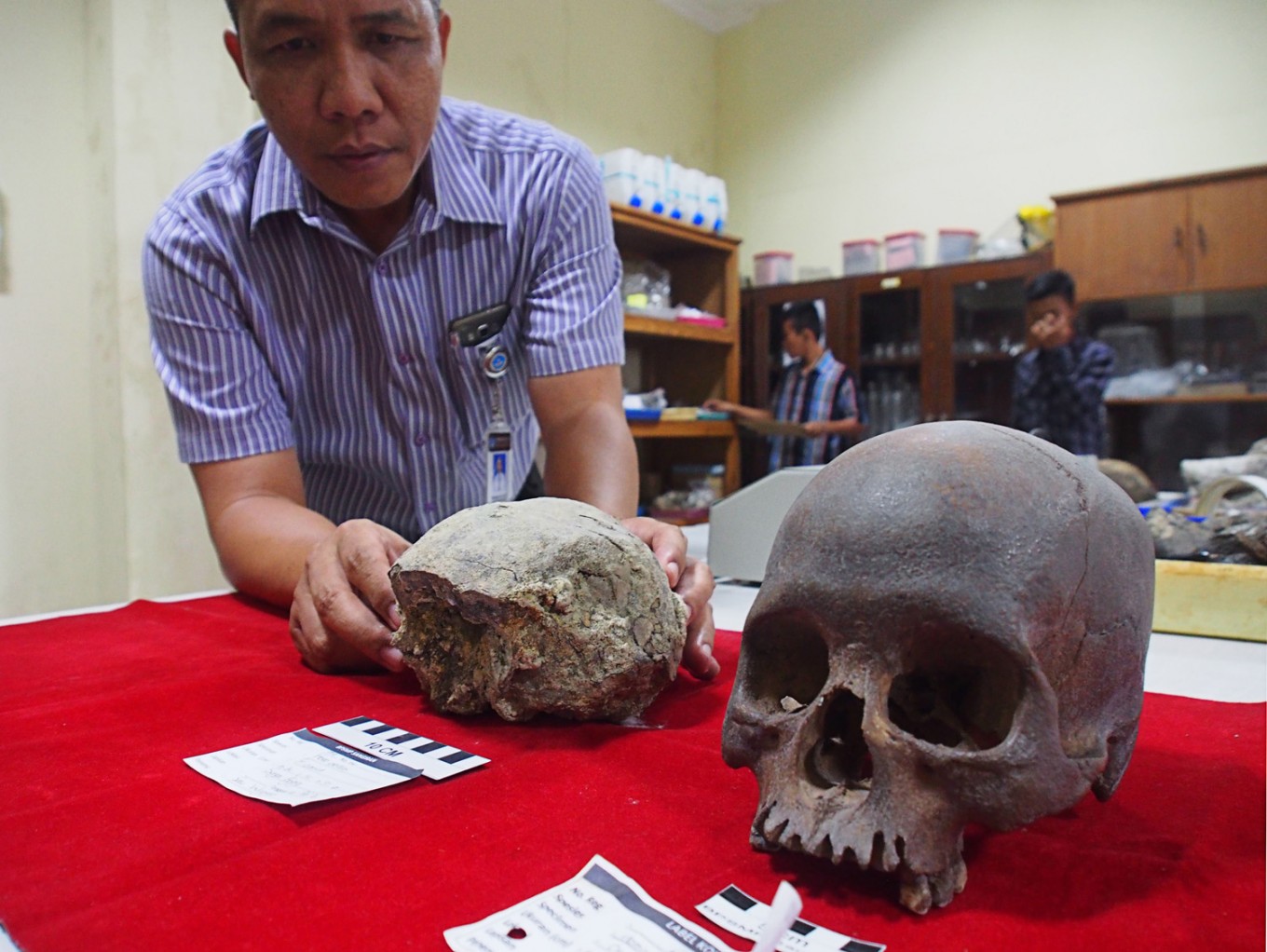Popular Reads
Top Results
Can't find what you're looking for?
View all search resultsPopular Reads
Top Results
Can't find what you're looking for?
View all search resultsAncient human skull discovered in Sangiran
Change text size
Gift Premium Articles
to Anyone
A
fter the absence of any discoveries of ancient human fossils for 80 years, a resident of Sragen, Central Java, found a Homo erectus skull in Sangiran, an archaeological site in the regency, in February.
The skull was found in an area along the Bojong River in Manyarejo village, Plupuh district, Sragen, and is considered a rare and important discovery. Most of the fossils discovered in the Sangiran Dome are from animals or plants.
“The discovery of the ‘archaic’ Homo erectus skull fossil is really special. We just announced it today because the fossil first needed to be examined by Sangiran Museum’s paleoanthropology team,” Sukronedi, head of the Ancient Human Site Conservation Agency (BPSMP) Sangiran, said on Tuesday.
The skull was found by 56-year-old Manyarejo villager Setu Wiryorejo, and is 14 centimeters long by 12 cm wide, with a height of around 10 cm. The skull’s volume is around 800 cubic centimeters, less than the volume of the skulls of Homo sapiens, which reach 1,400 cc.
“This archaic skull fossil adds to around 100 ancient human skulls we have. For the archaic type, we now have two fossils. The first fossil was found in 1936 and the second is the one we found in February 2016,” said Sukronedi.
The first Homo erectus skull was found by Gustav Heinrich Ralph von Koenigswald, a paleontology expert from Berlin, Germany, in 1936. Since then, no Homo erectus fossils have been found in Sangiran until this year.
Archaic fossils are one of three types of Homo erectus, along with the typical and progressive types. Archaic Homo erectus are the oldest of the species, and lived around 1.5 million to 1 million years ago. Typical Homo erectus lived in the period of 800,000 to 300,000 years before the Common Era (BCE), while progressive Homo Erectus lived from 300,000 to 100,000 years BCE.
“No progressive Homo erectus fossils have ever been found in Sangiran. They have only been found in Sambungmacan [Sragen] and Ngandong [Blora],” said Sukronedi.
He said the museum would give Setu Wiryorejo, who discovered the archaic fossil, a cash prize and an certificate to show its appreciation. Setu’s name will also be emblazoned on the glass box where the archaic fossil will be displayed.
“We have prepared compensation from Rp 300,000 [US$22.71] to tens of millions of rupiah, depending on how important the fossil discovery is. We are preparing Rp 25 million for the discoverer of this archaic Homo erectus skull,” said Sukronedi.
 Precious collection – An archaic Homo erectus skull (left) is displayed at the museum after being discovered near the Bojong River in Plupuh, Sragen, Central Java, in February. The skull is the first ancient human fossil discovered in the area in 80 years. (thejakartapost.com/Ganug Nugroho Adi)
Precious collection – An archaic Homo erectus skull (left) is displayed at the museum after being discovered near the Bojong River in Plupuh, Sragen, Central Java, in February. The skull is the first ancient human fossil discovered in the area in 80 years. (thejakartapost.com/Ganug Nugroho Adi)
Setu explained that the archaic fossil he found was hemmed in rocky ground. The cane farmer said he pried it out using a crowbar.
“I thought it was an animal fossil. I only knew it was an ancient human skull after I handed it over to Sangiran Museum,” said Setu.
Setu said he often found fossils at archeological sites in Sangiran. Over the last 20 years, he has spent time searching for fossils around the Bojong River. Dozens of fossils that he discovered, including elephant and turtle fossils, are now displayed at the museum.
“I’ve never sold fossils from Sangiran. I just want to help the museum. Many foreigners have come here to buy the fossils but I never sell them,” said Setu.
Along with the archaic Homo erectus fossil, Sangiran Museum also received a giant elephant tusk from a resident of Banjarejo, Grobogan, Purwodadi regency. BPSMP Sangiran experts are cleaning the ivory, which consists of several smaller pieces, in their laboratory. It is estimated that the fossil was from an elephant that lived around 700,000 years ago.
“We will first clean them of soil before we glue them together, returning these fossil pieces to their complete form,” said Sukronedi.
He added that the tusk was likely to reach four meters long but some parts had not yet been recovered.
Sukronedi said the ivory fossil from Grobogan was smaller than one previously discovered in Sangiran, which reached more than four meters.
The Sangiran ivory fossil is now on display in the museum’s exhibition room.
The Sangiran Dome archeological site covers 56 hectares over Gemolong, Kalijambe and Plupuh districts in Sragen regency and Gondangrejo district in Karanganyar regency. (ebf)










